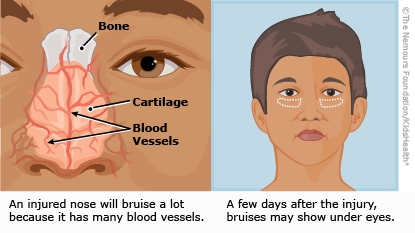Nasal Contusion: How to Care for Your Child
Injuries to the nose are common and usually don't cause lasting problems. Your child's injury should improve in a couple of weeks.


Your child has a bruised nose. A bruise is also called a "contusion," so a bruise on the nose is also called a "nasal contusion." A bruise happens when a part of the body is struck and small blood vessels under the skin are injured. Blood then leaks from these vessels, spreads under the skin, and usually forms the tender, purplish mark that we call a bruise.
A bruise on the nose can look dramatic and be uncomfortable. In the first few days after the nose is injured, the bruise and swelling may even spread to the area around the eyes. This is normal and not a cause for concern. The swelling should go away within a few days. Over the next 2 weeks, the bruise should gradually become less tender and fade in color until it is gone.

-
For pain, a medication may help your child feel better:
-
For children under 6 months, you may give acetaminophen.
-
For children over 6 months, you may give acetaminophen OR ibuprofen, if recommended by your health care provider.
-
Sleeping with the head raised can help reduce swelling.
-
For the next 2 days, apply a cold pack to the bruised area every few hours while your child is awake. Leave the cold pack in place for 10-15 minutes each time. Wrap the cold pack in cloth or a towel. Do not apply ice directly to the skin.
-
If possible, your child should avoid blowing the nose and drinking hot liquids for the first few days since these may cause bleeding.
-
If a nosebleed develops, have your child sit up and tilt the head slightly forward. Gently pinch the nostrils or soft part of the nose using the index finger and thumb and hold it constantly for 10 minutes.

-
The nose doesn't return to its normal shape or appears crooked after swelling goes down in 3-5 days.
-
The bruise doesn't go away after 2 weeks.
-
The bruise remains painful or becomes more painful.
-
Your child feels as if the nose is blocked.
-
The swelling increases.
-
Your child develops a fever.

Your child:
-
Develops a nosebleed that won't stop after two attempts of applying pressure for 10 minutes each.
-
Becomes weak or dizzy.
-
Develops a severe headache.
-
Seems confused or becomes drowsy.